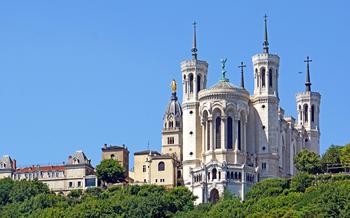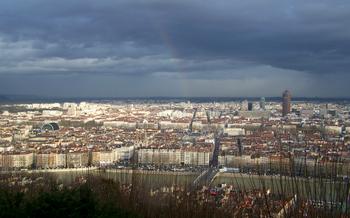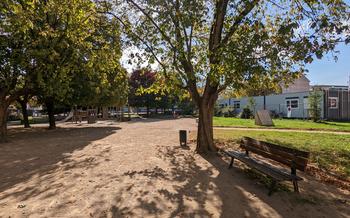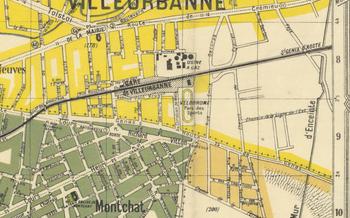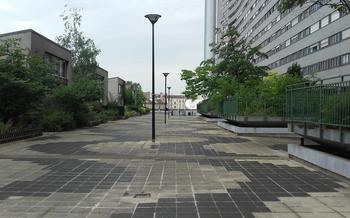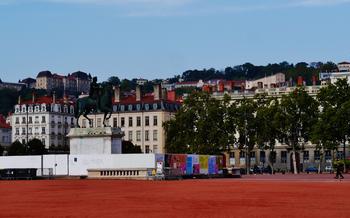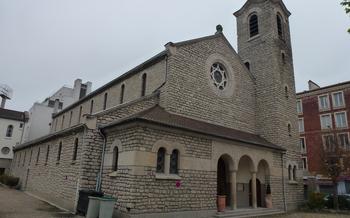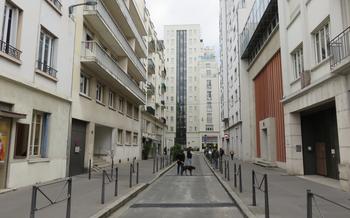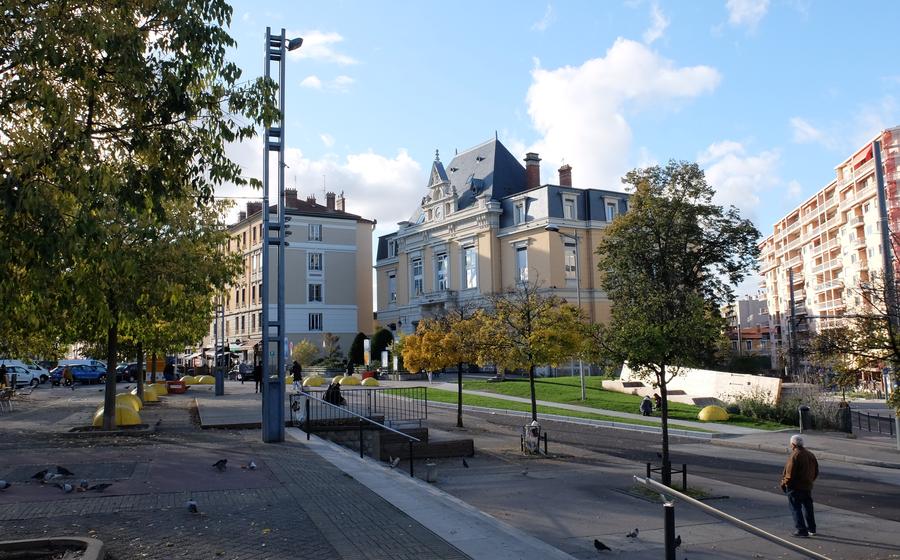
Basilique Notre Dame de Fourvière
- History of the Basilica
- Exterior Architecture
- Interior Architecture
- Religious Significance
- Panoramic Views
- Gardens and Surroundings
- Guided Tours
- Accessibility
- Dress Code and Etiquette:
- Photography and Videography
- Local Cuisine and Restaurants:
- Souvenirs and Gift Shops:
- Events and Concerts:
- Insider Tip: Unveiling the Tranquil Charm of the Basilica
History of the Basilica
The Basilique Notre Dame de Fourvière stands as a testament to Lyon's rich architectural and religious heritage. Its construction spanned from 1872 to 1884 under the leadership of architects Pierre Bossan and Sainte-Marie Perrin. The basilica's design reflects a harmonious blend of architectural styles, drawing inspiration from Romanesque, Byzantine, and Gothic traditions.
The decision to build the basilica arose from a combination of religious fervor and civic pride. In the aftermath of the Franco-Prussian War, Lyon sought to honor the Virgin Mary, who was believed to have protected the city during the conflict. The basilica's construction was marked by numerous challenges, including financial constraints and the need to adapt to the challenging terrain upon which it was built.
Throughout its history, the Basilique Notre Dame de Fourvière has witnessed significant events and hosted notable figures. Pope John Paul II visited the basilica in 1986, and it has been a popular pilgrimage site for centuries, attracting millions of visitors each year. The basilica's enduring legacy continues to inspire awe and devotion among locals and visitors alike.
Exterior Architecture
The Basilique Notre Dame de Fourvière stands as a testament to the grandeur of Neo-Byzantine architecture. Its imposing facade, adorned with intricate sculptures and mosaics, captivates the eyes of visitors from afar. The central portal, flanked by two bell towers, features a detailed depiction of the Fourvière Virgin, surrounded by angels and saints. The meticulous craftsmanship and symbolism of these sculptures add depth and meaning to the basilica's exterior.
The bell towers, reaching towards the sky, serve as a beacon of faith and devotion. Each tower houses a massive bell, the largest of which, known as the "Bourdon de Fourvière," weighs over 8 tons and rings out with a deep, resonant tone that echoes across the city. The intricate carvings and patterns adorning the towers showcase the skill and artistry of the builders, creating a harmonious blend of architectural styles.
Interior Architecture
Step inside the Basilique Notre Dame de Fourvière, and you will be greeted by a breathtaking display of architectural mastery. The spacious interior, spanning over 86 meters in length, exudes an aura of grandeur and spirituality. The nave, flanked by two rows of towering columns, leads your gaze towards the apse, where the high altar stands as the focal point of the basilica. Elaborately carved from white marble, the altar features intricate sculptures depicting biblical scenes and celestial figures.
The side aisles, adorned with elegant stained glass windows, provide a serene and contemplative atmosphere. Each window narrates a biblical story through vibrant colors and intricate designs, casting a warm glow upon the interior. The stained glass masterpieces depict scenes from the life of Jesus, the Virgin Mary, and various saints, inviting visitors to immerse themselves in the rich history and symbolism of the Catholic faith.
Religious Significance
The Basilique Notre Dame de Fourvière holds immense religious significance as a place of worship and pilgrimage. Dedicated to the Virgin Mary, it serves as a spiritual center for Catholics worldwide. At the heart of the basilica lies the revered statue of Our Lady of Fourvière, a symbol of hope and devotion. According to legend, the Virgin Mary appeared to a young shepherdess named Claudine Augarde in 1870, requesting the construction of a church on the hilltop.
The basilica's religious importance is further highlighted by the numerous annual festivals and celebrations that take place within its walls. The most notable of these is the Feast of the Assumption of Mary, celebrated on August 15th. During this grand festival, thousands of pilgrims gather to honor the Virgin Mary, participate in processions, and offer prayers. Additional religious events include the Fête des Lumières (Festival of Lights) in December, where the basilica is illuminated with vibrant lights, and the Procession du Saint Sacrement (Procession of the Blessed Sacrament), a solemn ceremony held on the first Sunday after Easter.
Panoramic Views
The Basilique Notre Dame de Fourvière stands majestically atop the Fourvière hill, offering breathtaking panoramic views of the city and beyond. The terrace of the basilica, accessible to visitors, provides a unique platform to immerse oneself in the city's charm. From this elevated vantage point, the cityscape unfolds like a tapestry, with iconic landmarks and architectural wonders taking center stage. Gaze upon the spires of Vieux Lyon, the graceful curves of the Rhône River, and the vibrant neighborhoods that define Lyon's character. The panorama extends far into the distance, encompassing the verdant hills and the majestic Alps, creating a breathtaking backdrop for this sacred site.
Timing plays a crucial role in enhancing the panoramic experience. For those seeking the most vibrant views, the golden hours of sunrise and sunset paint the cityscape in warm, ethereal hues. As the sun dips below the horizon, the city transforms into a sea of twinkling lights, casting a romantic glow on the surrounding landscapes. Whether bathed in the warm glow of dawn or the shimmering lights of dusk, the panoramic views from the Basilique Notre Dame de Fourvière offer a truly unforgettable experience.
Gardens and Surroundings
The Basilique Notre Dame de Fourvière is not only a stunning architectural marvel but also boasts beautiful and serene surroundings. As you step out of the basilica, you will be greeted by the enchanting landscaped gardens that adorn its exterior. These gardens, meticulously designed, offer a tranquil oasis amidst the city's bustling energy.
Take a leisurely stroll through the gardens, immersing yourself in the vibrant colors and fragrant scents of the diverse flora. Admire the carefully manicured hedges, flowerbeds, and sculptures that enhance the overall ambiance. Find a secluded bench to sit and soak in the peaceful atmosphere, relishing the tranquility of this sacred space.
One of the highlights of the gardens is the Sacré Cœur Chapel. This charming chapel, constructed in the 19th century, exudes a distinct architectural style, blending Romanesque and Byzantine influences. Step inside to marvel at the intricate stained glass windows that bathe the interior in a kaleidoscope of colors. The chapel is a testament to the enduring faith and devotion of the local community.
Adjacent to the basilica, you will find a delightful park that offers a variety of recreational opportunities. Whether you seek a leisurely stroll, a brisk jog, or a fun-filled family picnic, this park provides the perfect setting. Children will particularly enjoy the playground, with its swings, slides, and other exciting attractions.
As you explore the gardens and park, take a moment to appreciate the harmonious coexistence of nature and spirituality. The Basilique Notre Dame de Fourvière, with its landscaped surroundings, offers a truly immersive experience that will leave you feeling both inspired and rejuvenated.
Guided Tours
Visitors can delve deeper into the history, architecture, and religious significance of the Basilique Notre Dame de Fourvière by joining one of the guided tours offered. These tours are conducted in multiple languages, ensuring that international visitors can also benefit from the insights provided by knowledgeable guides.
The tours typically last for around an hour and cover a wide range of topics, including the basilica's construction, its architectural features, and the religious significance of the site. Guides often point out specific details and artworks that visitors might otherwise miss, enriching the overall experience.
Advance booking for guided tours is recommended, especially during peak tourist seasons, to secure a spot and avoid disappointment. Tour prices vary depending on the size of the group and the language of the tour.
Accessibility
The Basilique Notre Dame de Fourvière is committed to ensuring accessibility for visitors of all abilities.
Public Transportation:
- Metro: Take the D line to the Vieux Lyon station and transfer to the funicular (line F1) to reach the basilica.
- Bus: Several bus lines (C13, C18, and 33) stop near the basilica.
Accessibility Features:
- Wheelchair Access: The basilica is wheelchair accessible, with ramps and elevators available throughout the building.
- Accessible Toilets: Accessible toilets are available on the ground floor.
- Audio Guides: Audio guides are available in several languages, including English, French, Spanish, and German. These guides are equipped with induction loops for hearing aid users.
Parking:
- Accessible Parking: Limited accessible parking spaces are available near the basilica. Please inquire with the basilica staff for assistance.
- Public Parking: There is a public parking lot located near the basilica, offering ample parking spaces for visitors.
Dress Code and Etiquette:
When visiting the Basilique Notre Dame de Fourvière, it is essential to dress respectfully and modestly, as it is a sacred and religious space. Visitors should avoid wearing overly revealing or casual clothing that might be considered inappropriate in such a setting. It is recommended to wear comfortable and conservative attire, such as long pants or a skirt below the knee, and a shirt or blouse that covers the shoulders. Additionally, it is important to be mindful of noise levels and maintain a respectful silence while inside the basilica. Visitors should avoid talking loudly or engaging in disruptive behavior that might disturb others who are praying or contemplating. By respecting the dress code and etiquette, visitors can contribute to the peaceful and sacred atmosphere of the basilica.
Photography and Videography
Photography enthusiasts will delight in capturing the basilica's grandeur, both inside and out. While photography is generally permitted, it's essential to be respectful of the sacred nature of the space. Avoid using flash or tripods that may disturb other visitors or interfere with religious services. Certain areas, such as the altar or during mass, may have restricted photography, so it's advisable to be mindful of signage or ask a staff member for guidance.
To capture the best shots, consider visiting during the golden hours of dawn or dusk when the basilica's exterior glows with a warm, ethereal light. The intricate details of the facade and bell towers are particularly striking in these soft, diffused light conditions. For interior shots, focus on the stunning stained-glass windows, capturing the vibrant colors and intricate biblical scenes they depict. Experiment with different angles and perspectives to convey the basilica's vastness and awe-inspiring atmosphere.
Local Cuisine and Restaurants:
When visiting Villeurbanne, take the opportunity to indulge in the region's culinary delights. In the vicinity of the Basilique Notre Dame de Fourvière, you'll find a range of restaurants offering traditional French cuisine. For an authentic experience, try "bouchons Lyonnais," cozy eateries serving hearty Lyonnais fare like "quenelles" (dumplings) and "salade Lyonnaise" (bacon and egg salad). Don't miss the chance to savor the region's renowned cheeses, such as Saint-Marcellin and Bleu du Vercors-Sassenage. Pair your meal with a glass of local wine from the Rhône Valley, known for its prestigious crus like Côte-Rôtie and Hermitage. For a sweet treat, indulge in a "tarte à la praline" or a "coussin de Lyon," a delicate macaron-like pastry. Remember, the best way to discover Lyon's culinary scene is to venture into the side streets and explore the city's hidden gastronomic gems.
Souvenirs and Gift Shops:
Within the basilica premises, you'll find gift shops that offer a diverse selection of souvenirs to remember your visit. You'll find classic religious items like rosaries, medals, and statues, each with its unique symbolism and significance. For a more personalized touch, consider purchasing a handcrafted souvenir from one of the local artisans. These trinkets often showcase the region's rich cultural heritage and make for cherished keepsakes.
When selecting a gift from the basilica's gift shop, take your time to browse the collection. You'll discover an array of items that cater to different tastes and budgets. Whether you're looking for a meaningful token for a loved one or a unique reminder of your pilgrimage, the basilica's gift shops have something for everyone.
Events and Concerts:
The Basilique Notre Dame de Fourvière is not just a religious site but also a cultural and artistic hub. Throughout the year, the basilica hosts a variety of special events, concerts, and exhibitions that attract locals and tourists alike. These events showcase the basilica's awe-inspiring acoustics and provide an opportunity for visitors to experience its beauty and grandeur in a unique way.
One of the highlights of the basilica's event calendar is the annual Fourvière Festival, held every summer. This prestigious festival features a diverse lineup of classical music concerts, opera performances, and dance recitals, attracting renowned artists from around the world. The basilica's majestic setting provides a truly unforgettable backdrop for these performances, creating a magical and immersive experience for attendees.
In addition to classical music, the basilica also hosts contemporary music concerts, organ recitals, and even film screenings. These events offer a fresh perspective on the basilica's rich history and traditions, while also attracting a younger and more diverse audience.
To ensure a memorable experience, it's advisable to book tickets in advance for popular events, especially during the Fourvière Festival. The basilica's website and social media channels provide up-to-date information on upcoming events and concerts, allowing visitors to plan their visit accordingly.
Insider Tip: Unveiling the Tranquil Charm of the Basilica
To fully appreciate the serene beauty of the Basilique Notre Dame de Fourvière, I recommend visiting during the early morning hours. As the sun casts a warm glow across the city, the basilica exudes a tranquil aura, free from the throngs of tourists that typically fill its halls later in the day. Take advantage of this peaceful ambiance to wander through the intricate details of the interior, marveling at the stained glass windows and sculptures without the distractions of a bustling crowd. The subdued lighting during this time creates an almost ethereal atmosphere, allowing you to connect with the basilica's spiritual essence on a deeper level. Whether you seek solace or inspiration, an early morning visit to the Basilique Notre Dame de Fourvière promises an unforgettable experience.
